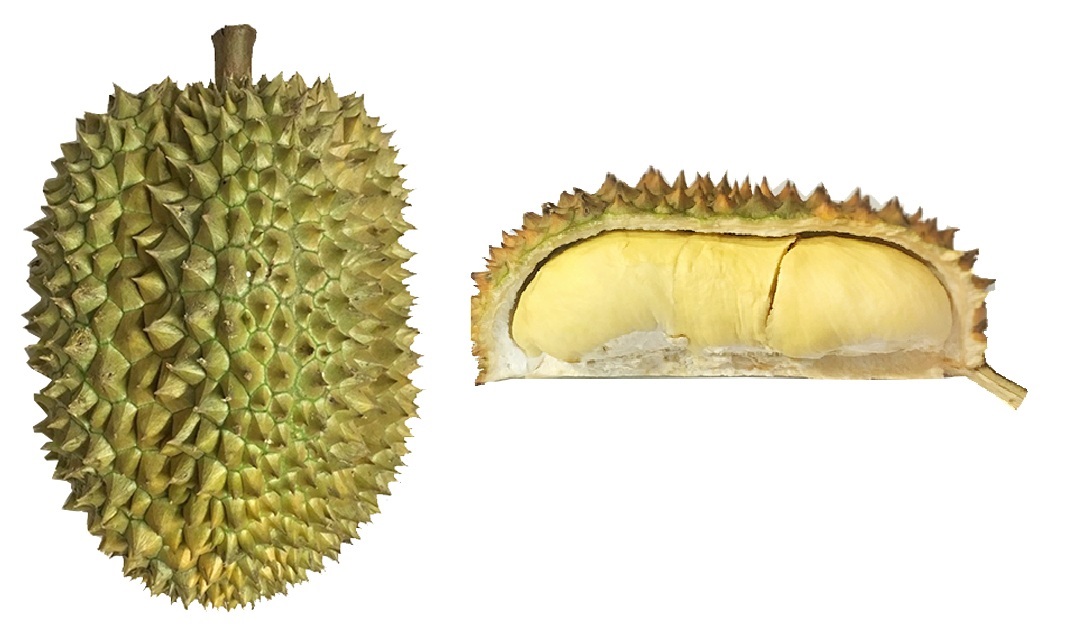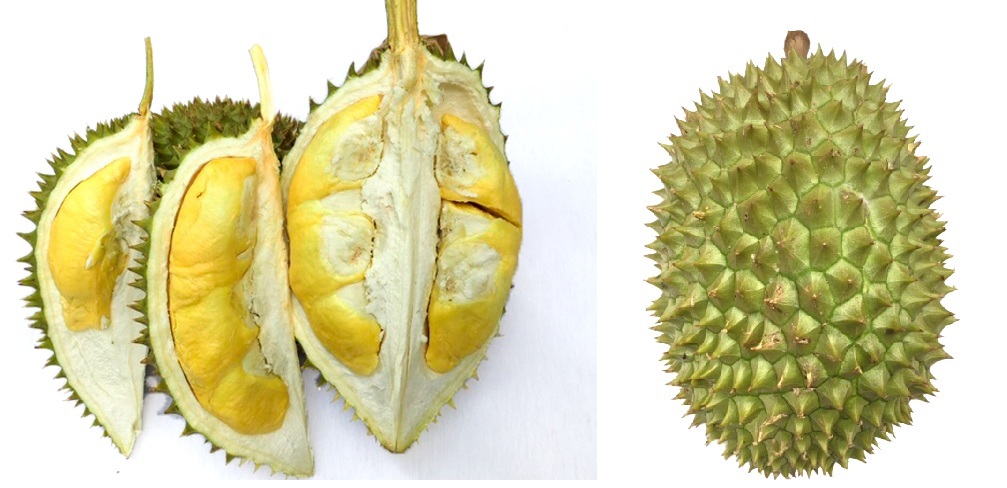Cái Mơn is a place resides in Chợ Lách, Bến Tre province. The word “Cái” in the name “Cái Mơn” means a big canal, while “Mơn” is a mispronounciation of the word “Khmu” in Khmer language that means honey. According to the author Sơn Nam, in history, the river banks in Cái Mơn had colonies of bees as this is the land of fruits. In 2005, Cái Mơn was recognized by Viet Nam Guinness Record Organization as “Viet Nam’s largest provider of fruits crossbred by farmers”. Among the fruits of this area, durian is one of the most well-known products with the quality and reputation that have a direct link to the name of “Cái Mơn” for almost a century. It has been recognized in the lives and folk song and proverbs of the locals: “Durian and mangosteen of Cái Mơn; Clam of Cồn Lợi, tobacco of Mỏ Cày.”

Monthong durian

Ri6 durian
Durian of Cái Mơn includes two varieties: Monthong and Ri6.
Monthong durian has oblong shape, the top is pointy, defined capsules. The husk is yellow which turns brown when the fruit is ripe. The flesh has pale yellow colour, medium amount of fibre. The flesh is thick, with sweet and rich taste and a faint aroma. The percentage of the seeds is low. Fruit weight: ≥ 3 kg. Husk percentage (of weight): ≤ 64 %. Flesh percentage (of husk): ≥ 29.6 %. Seed percentage (of weight): ≤ 6.4 %. Flesh thickness: ≥ 14 mm. Nutrition and mineral-wise, Cái Mơn durian has superior quality: energy: ≥ 123 kcal; Brix: ≥ 19 °B; fat: ≥ 2.8 %; Protein: ≥ 3 %; moisture: ≤ 71 %; Vitamin C: ≥ 35 mg/100g. Mineral content: Ca: ≥ 35 mg/kg; K: ≥ 3668 mg/kg; Na: ≥ 25.4 mg/kg; Fe: ≥ 2.2 mg/kg; Zn: ≥ 2.1 mg/kg.
Ri6 durian has ellipse shape, the husk is green which turns yellow when ripe, the spikes are long and sparse, the spike foots are shiny and has pentagon shape. The flesh has deep yellow colour, no fibre, dry and not sticky when held. The flesh is thick, with sweet and rich taste and strong aroma. The percentage of the seeds is low. Fruit weight: ≥ 2 kg. Husk percentage (of weight): ≤ 68 %. Flesh percentage (of husk): ≥ 24 %. Seed percentage (of weight): ≤ 8 %. Flesh thickness: ≥ 14 mm. Nutritional content: energy: ≥ 103 kcal; Brix: ≥ 20 °B; fat: ≥ 2 %; Protein: ≥ 2.4 %; moisture: ≤ 76.7 %; Vitamin C: ≥ 23.7 mg/100g. Mineral content: Ca: ≥ 30 mg/kg; K: ≥ 3966 mg/kg; Na: ≥ 15 mg/kg; Fe: ≥ 1 mg/kg; Zn: ≥ 3.7 mg/kg.
The geographical area has specific traits of topography, pedology, hydrology and climate which result in the specific quality of Cái Mơn durian. Topography-wise, the area has a high altitude, with high mounds near the major rivers, and coastal sand dunes. Pedology-wise, the mechanical composition of the soil is clay silt. The soil has good drainage, the amounts of organic matters, total protein, exchange calcium and potassium are high. The abundant water supply from major rivers such as Tiền Giang, Ba Lai, Hàm Luông, and Cổ Chiên helps the flesh of Cái Mơn durian from having clots when ripe, unlike durian from areas with limited water supply. Moreover, the water has rich nutritional content, no salinity, slightly basic pH level, and high potassium, calcium and magnesium content resulting in the special taste of the product. The climate of the area is especially suitable to the growth and development of durian trees with the average temperature of 27 °C and low temperature variance; the annual average rainfall is low at 1200 – 1600 mm, concentrated in July, August and September when the harvest is completed, resulting in a firmer texture of Cái Mơn durian flesh; the temperature variance between day and night is high; the lowest humidity is in December and January.
Additionally, the traditional knowhows of the local producers such as cloning, plantation designing including digging ditches, making planting columns, building dykes, storing water in wells also contribute to the unique quality of Cái Mơn durian.
The geographical area includes the communes of Hòa Nghĩa, Hưng Khánh Trung B, Long Thới, Phú Phụng, Phú Sơn, Sơn Định, Tân Thiềng, Vĩnh Bình, Vĩnh Hòa, Vĩnh Thành and Chợ Lách town of Chợ Lách district; the communes of Tân Phú, Tiên Long, Tiên Thủy and Phú Đức of Châu Thành district; the communes of Nhuận Phú Tân, Hưng Khánh Trung A, Phú Mỹ, and Phước Mỹ Trung of Mỏ Cày Bắc district, Bến Tre province.